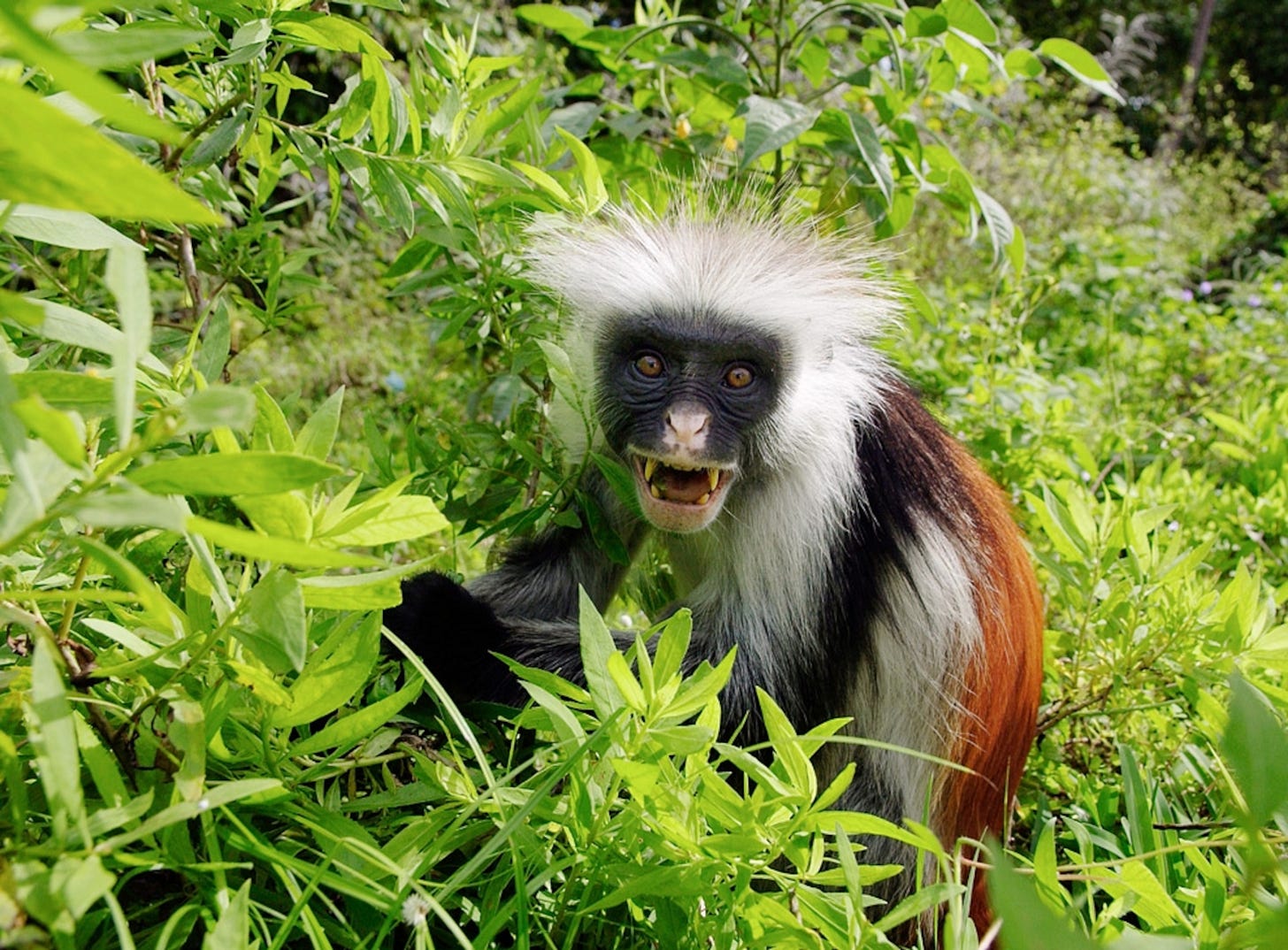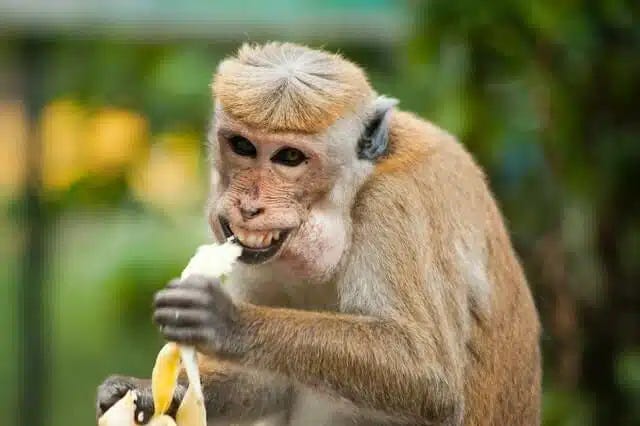Climate Wackos Greatest Hits 1: "Global Warming Indigestion May Kill Gorillas, Monkeys"
Stranger than fiction research and stories, not spoofs!
Above: bad gas and angry about climate change. Red colobus monkeys would be among the primates most threatened by warming-induced leaf changes, a new study says. Getty Images
Dear Readers, welcome to the premier of Climate Wackos Greatest Hits (TM). In this target rich environment I remain determined to track down and curate only the best for my audience. These are not spoofs and were published with serious intent.
The recent “soft opening” of Climate Wackos Greatest Hits (TM) resulted in 10^6 restacks and crashed the Substack servers:
In honor of unofficial, earlier versions of Climate Wackos Greatest Hits (TM), we also share:
So without further adieu, I present the following article:
“Global Warming Indigestion May Kill Gorillas, Monkeys” (hat tip to DawnTJ90).
Above: Cute now, but will bite you a new one if pissed off.
Global Warming Indigestion May Kill Gorillas, Monkeys
By Christine Dell'Amore (literal Italian translation: Christine of Love) of National Geographic.
Global warming-induced indigestion could help make mountain gorillas and other leaf-eating primates sitting ducks for extinction, a new study says.
Annual temperatures are predicted to rise 3.6 degrees Fahrenheit (2 degrees Celsius) by mid-century in some climate models. Leaves that grow in hotter air contain more fiber and less digestible protein, meaning leaf-eaters would take longer to process their food.
In addition, the higher temperatures may force the animals to spend more time lounging in the shade to avoid overheating.
Such changes may force some gorilla and monkey species to sit still for long periods—time that would otherwise be used for finding food, protecting territory, or maintaining social bonds, the study says.
The inaction, combined with less nutritious food, could eventually cause mountain gorillas and African colobines—a large group of species including colobus monkeys—to go extinct, the study predicts.
"A two-degree temperature increase is not a very farfetched idea," said study leader Amanda Korstjens, a biological anthropologist at Bournemouth University in the U.K.
"Animals can adapt ... and maybe primates will find another way of coping," she added. But "I expect that they are at their limits already."
Flexible Fruit-Eaters
Korstjens and colleagues compared climate models with previously published data on primates' behavior, diets, and group sizes worldwide.
Based on the data, the team created global maps that show where primates exist now and where climate change is predicted to cause die-offs.
The data revealed that the expected higher temperatures shouldn't affect most South American primates, which eat highly digestible fruit. Also, South American primate habitats are less fragmented by agriculture and encroaching deserts than most primate habitats in Africa, Korstjens said.
Around the world, fruit-eaters—such as baboons and vervet monkeys in Africa—would also be better off. They occupy a wider range of habitat than leaf-eaters, which are confined to a narrow belt near the Equator, according to the study, published in the journal Journal of Biogeography.
Above: suffering from climate indigestion.
"Not as Stable As You Think"
The threatened primates could possibly adapt to the global warming-induced changes by changing their diets, but no one knows for sure.
Colobines could eat some fruit, but their highly leaf adapted stomachs aren't equipped for all-fruit diets, Korstjens said.
Such assumptions of inadaptability may be weak points in the new study, said Colin Chapman, a primate ecologist at Montreal's McGill University, who was not involved in the study.
"It's not clear how flexible [colobines] could be."
But "if the assumptions are correct," Chapman said, "shows a pretty big potential in changes in distribution and extinction risk."
Mountain gorillas are in a particularly serious bind, he added. They have little access to fresh fruit in their high-altitude habitats, and they're "sitting on top of mountains with nowhere else to go."
A hotter Africa would also pose a threat for conservation efforts, Chapman said.
Well-managed national parks may be able to keep out poachers and loggers, for example, but they can't protect against temperature changes, he said.
"You think you have a perfectly stable national park," he said, "all of the sudden it's not as stable as you think."
Climate Wackos Greatest Hits - Bonus Section
Professor Amanda Korstjens, original author of the paper
The Original Paper
Apes in a changing world - the effects of global warming on the behaviour and distribution of African apes
Authors: Lehmann, J., Korstjens, A.H. and Dunbar, R.I.M.
Journal: Journal of Biogeography
Volume: 37
Issue: 12
Pages: 2217-2231
eISSN: 1365-2699
ISSN: 0305-0270
DOI: 10.1111/j.1365-2699.2010.02373.x
Abstract:
Aim In this study we use a modelling approach to identify: (1) the factors responsible for the differences in ape biogeography, (2) the effects that global warming might have on distribution patterns of African apes, (3) the underlying mechanisms for these effects, and (4) the implications that behavioral flexibility might be expected to have for ape survival. All African apes are highly endangered, and the need for efficient conservation methods is a top priority. The expected changes in world climate are likely to further exacerbate the difficulties they face. Our study aims to further understand the mechanisms that link climatic conditions to the behaviour and biogeography of ape species.Location Africa. Method We use an existing validated time budgets model, derived from data on 20 natural populations of gorillas (Gorilla beringei and Gorilla gorilla) and chimpanzees (Pan troglodytes and Pan paniscus), which specifies the relationship between climate, group size, body weight and time available for various activities, to predict ape distribution across Africa under a uniform worst-case climate change scenario. Results We demonstrate that a worst-case global warming scenario is likely to alter the delicate balance between different time budget components. Our model points to the importance of annual temperature variation, which was found to have the strongest impact on ape biogeography. Our simulation indicates that rising temperatures and changes in rainfall patterns are likely to have strong effects on ape survival and distribution, particularly for gorillas. Even if they behaved with maximum flexibility, gorillas may not be able to survive in most of their present habitats if the climate was to undergo extreme changes. The survival of chimpanzees was found to be strongly dependent on the minimum viable group size required. Main conclusions Our model allows us to explore how climatic conditions, individual behavior and morphological traits may interact to limit the biogeographical distributions of these species, thereby allowing us to predict the effects of climate change on African ape distributions under different climate change regimes. The model suggests that climate variability (i.e. seasonality) plays a more important role than the absolute magnitude of the change, but these data are not normally provided by climate models.










These people are not serious scientists in any way, shape, or form. However, they are serious Marxist revolutionaries sowing chaos, and havoc and doing their part to burn down the system. They must be recognized as such, and we as counter revolutionary’s must keep ourselves educated to try and stop their diabolical evilness.
Rick, those are excellent points regarding bad gas, and perhaps the basis of a lawsuit against the oil and gas companies🤔
🤣